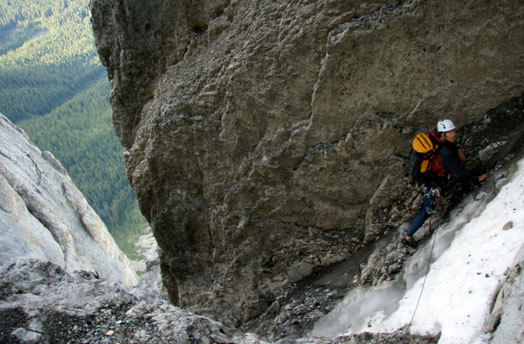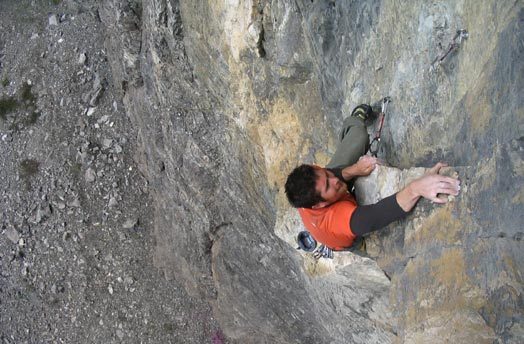
Brandon Pullan working through Pitch 14 (5.7) on the right side of the east face (III 5.9, 1000m) of Mt. Louis (2682m), Alberta, Canadian Rockies. This climb is one of three potential new routes established by Pullan and company in the Canadian Rockies this season. [Photo] Will Meinen
The Canadian Rockies still have vast potential for new routes, and with some free time I thought tapping into it, sans guidebooks, would be an adventure. With eager partners (Steve Gale, Will Meinen and other local climbers) and inspired by Andy Genereux’s route The Devil’s Right Hand (5.11b, 200m) and Jeff Relphs’ Hand in the Honey Pot (5.11b/c 500m) on East End of Rundle Wall, we began looking in March for new lines up old, classic faces.
Steve, Will and I made our first new ascent of the season on Yamnuska (2240m)–the classic 2.5 kilometer long, 300-meter high crag. On May 20, after a few days of effort between snow squalls we ascended, ground up, an unclimbed line that had been first attempted nearly twenty years ago by the late Brian Wallace. Hot Dogg’n It (5.10 A1, 220m) is well protected on quality rock on Yamnuska’s West End. A week later I returned with Sonnie Trotter and Nich Rochocewich to free the line, which goes at 5.12c. The business is right off the ground on loose rock. A couple roof traverses and tricky dihedrals make for fine, technical, exposed face climbing on the first four pitches; the last couple lengths are wandering 5.8.

Brandon Pullan on the crux pitch (Pitch 1) of Hot Dogg’n It (5.10 A1 or 5.12c, 220m), Yamnuska (2240m), Canadian Rockies. [Photo] Steve Gale
Ha Ling (2408m) is a local peak in Canmore’s backyard. Some old aid routes on the peak have been freed recently, but rarely is a new route established–the few routes there are all classics. The most recently established important line, Sisyphus Summits (1994), was bolted on rappel, so a couple weeks after we completed Hot Dogg’n It, Nick and I decided to have a go, ground up, on Ha Ling’s northwest ridge. We made the first ascent of The Northwest Shoulder (5.8, 600m) through snowfall on June 10. The route is especially long for Ha Ling, as it zig-zags across three obvious ramps of nearly perfect rock. The crux pitches, five and six, are long and engaging. Pitch 5 ascends a blank wall next to a wet chimney. The final six pitches can be simulclimbed up bombproof runnels and cracks.
On July 1 Will and I decided to push a climb up the east face of Mt. Louis (2682m), a Rockies must-do. It is known for its large, aesthetic, flat, diamond-shaped wall on its east face, and for its striking summit. The summit comes to an abrupt point with a big cross and has sheer cliffs on all sides, which is unusual, as most peaks in the Canadian Rockies have non-technical avenues to the top. Taking advantage of long summer days and great weather, we headed in. I gave my car to a buddy who came for the hike, and we hoped the car would be in the parking lot when we returned.
Our route began on the east face in a shallow drainage under the prominent diamond. There are a number of possible variations in this area, where Jeff Marshall with Steve DeMaio and Mark Synnott with Kevin Thaw, have climbed bottom to top. After a few hundred meters we climbed a series of spectacular ridges, then we gained the main wall via a leap over a deep gap. Eight hundred meters up, at dusk, Will pushed on to an obvious ridge that led to the summit. He took a twenty-five footer, stopped by a knife blade, and he was left with a noodley ankle. The accident slowed us down for the final pitch and the descent; we wished we had food and bivy gear. Avoiding the ridge, I took an obvious chimney to the summit instead and belayed Will up to join me for the golden sunset.
After seven 60-meter rappels and a two-hour scree slog that left Will’s ankle the size of a grapefruit, we caught some sleep on the valley floor at 2 a.m. Too cold to sleep, I woke Will, whose body was in desperate need of rest, and we headed for the parking lot, hoping to find the car. We arrived at sun up to find no vehicle, so we hitchhiked out, happy with our sleepless but fun twenty-four hours.
As we found no fixed gear, had to trundle a large block in our path, and discovered the route descriptions of other climbs on the east face differed from ours, we figure that at least some of our terrain is new. The climb (III 5.9, 1000m) is worthwhile because of the unique exposure along the right side of the diamond and rare views of the U-shaped valley to the north.
We’re not the only locals out and about in the Rockies this year. Climbers such as Andy Genereux, Sonnie Trotter, Jeff Relph, Jon Jones and others have been establishing long, free routes more and more, sans guidebooks, slowly tapping into the potential for wild lines.

Will Meinen hobbling along the summit traverse on Mt. Louis (2682m) at sunset. Meinen took a fall near the top of the climb, injuring his ankle and complicating the descent. [Photo] Brandon Pullan